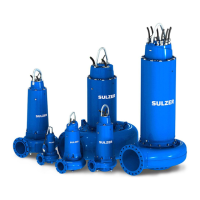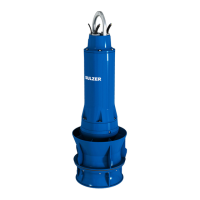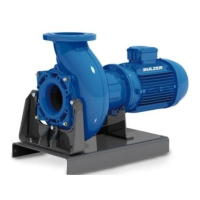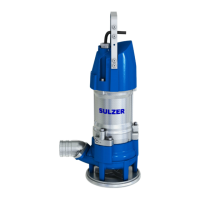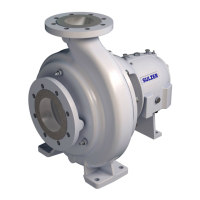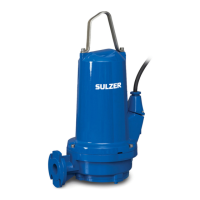Do you have a question about the Sulzer VMS and is the answer not in the manual?
Provides important information for reliable, proper, and efficient operation of the pump.
Explains the meaning of icons and symbols used in the manual and accompanying documentation.
Details on how to find and quote pump information from the nameplate for queries or orders.
Provides a table detailing shaft seal material codes according to EN 12756 standards.
Information regarding nominal and maximum current for VMS and VMS H6 pumps.
Lists available supplementary documentation apart from the main manual.
Defines the warranty period and conditions, including restrictions on modifications and use.
General safety instructions and responsibilities for product use and maintenance.
Specifies requirements for personnel involved in operation, maintenance, and installation.
Guidelines on safety regulations, original parts, and operating within the product's working range.
Emphasizes the importance of product labels and their legibility for safety.
Details safety measures to be taken during normal use and specific activities.
Safety precautions for operating the pump under normal conditions.
Critical safety measures for installation, maintenance, and repair activities.
Information on the environmentally friendly design and disposal of Sulzer products.
General guidelines for acting according to environmental laws and regulations.
Owner's responsibility for dismantling and environmentally friendly disposal of the product.
Describes the vertical, single, or multistage centrifugal pumps and their construction.
Explains the labeling system used to identify pump types and configurations.
Provides product information related to Ecodesign directives and energy efficiency.
Specifies the suitable applications and mediums for VMS pumps.
Explains the basic principle of pump operation and how pressure is generated.
Details the purpose and use of various connections for measurement, draining, and venting.
Describes the modular components used for assembling pumps to match specific applications.
Outlines the general working specifications, including temperature, pressure, and flow limits.
Provides detailed working range information for VMS pumps, referring to the nameplate.
Specifies the working pressure and temperature limits for VMS H 6 pumps.
Presents a table of seal codes, their materials, pressure class, and temperature ranges.
Information on pump suitability for environments with explosion risks indicated by stickers.
Explains ATEX marking indicators and their meaning related to explosion safety.
Details maximum allowable medium temperatures for ATEX motors based on their marking.
A checklist of essential points to verify before putting an ATEX-approved pump into operation.
Instructions for transporting the pump, including lifting and handling precautions.
Guidelines for storing the pump, including temperature and humidity recommendations.
Procedure for inspecting and maintaining the pump during storage periods.
Guidance on properly installing and positioning the pump to avoid piping stress.
Explains the pump indicators for flow direction and motor rotation direction.
Recommendations for installing a bypass line, especially when operating against a closed valve.
Advice on selecting and mounting a motor, including specifications and bearing requirements.
Step-by-step instructions for mounting a motor onto a pump.
Instructions for making electrical connections to the motor by authorized personnel.
General procedures and checks required before initial pump operation.
Commissioning steps for pumps in circuits with adequate supply pressure.
Commissioning steps for pumps in open circuits with a low liquid level.
Procedure for starting up a pump after a period of inactivity or storage.
Notes that the pump is externally controlled and does not require specific operation guidance.
Emphasizes the importance of regular maintenance and adhering to safety precautions.
Details lubrication requirements for motors, including bearing types and lubricant specifications.
Steps to protect seals and the pump during extended periods of non-operation.
Provides torque specifications for coupling shell assembly based on material and dimensions.
A troubleshooting guide listing common problems, their possible causes, solutions, and checkpoints.
Provides important information for reliable, proper, and efficient operation of the pump.
Explains the meaning of icons and symbols used in the manual and accompanying documentation.
Details on how to find and quote pump information from the nameplate for queries or orders.
Provides a table detailing shaft seal material codes according to EN 12756 standards.
Information regarding nominal and maximum current for VMS and VMS H6 pumps.
Lists available supplementary documentation apart from the main manual.
Defines the warranty period and conditions, including restrictions on modifications and use.
General safety instructions and responsibilities for product use and maintenance.
Specifies requirements for personnel involved in operation, maintenance, and installation.
Guidelines on safety regulations, original parts, and operating within the product's working range.
Emphasizes the importance of product labels and their legibility for safety.
Details safety measures to be taken during normal use and specific activities.
Safety precautions for operating the pump under normal conditions.
Critical safety measures for installation, maintenance, and repair activities.
Information on the environmentally friendly design and disposal of Sulzer products.
General guidelines for acting according to environmental laws and regulations.
Owner's responsibility for dismantling and environmentally friendly disposal of the product.
Describes the vertical, single, or multistage centrifugal pumps and their construction.
Explains the labeling system used to identify pump types and configurations.
Provides product information related to Ecodesign directives and energy efficiency.
Specifies the suitable applications and mediums for VMS pumps.
Explains the basic principle of pump operation and how pressure is generated.
Details the purpose and use of various connections for measurement, draining, and venting.
Describes the modular components used for assembling pumps to match specific applications.
Outlines the general working specifications, including temperature, pressure, and flow limits.
Provides detailed working range information for VMS pumps, referring to the nameplate.
Specifies the working pressure and temperature limits for VMS H 6 pumps.
Presents a table of seal codes, their materials, pressure class, and temperature ranges.
Information on pump suitability for environments with explosion risks indicated by stickers.
Explains ATEX marking indicators and their meaning related to explosion safety.
Details maximum allowable medium temperatures for ATEX motors based on their marking.
A checklist of essential points to verify before putting an ATEX-approved pump into operation.
Instructions for transporting the pump, including lifting and handling precautions.
Guidelines for storing the pump, including temperature and humidity recommendations.
Procedure for inspecting and maintaining the pump during storage periods.
Guidance on properly installing and positioning the pump to avoid piping stress.
Explains the pump indicators for flow direction and motor rotation direction.
Recommendations for installing a bypass line, especially when operating against a closed valve.
Advice on selecting and mounting a motor, including specifications and bearing requirements.
Step-by-step instructions for mounting a motor onto a pump.
Instructions for making electrical connections to the motor by authorized personnel.
General procedures and checks required before initial pump operation.
Commissioning steps for pumps in circuits with adequate supply pressure.
Commissioning steps for pumps in open circuits with a low liquid level.
Procedure for starting up a pump after a period of inactivity or storage.
Notes that the pump is externally controlled and does not require specific operation guidance.
Emphasizes the importance of regular maintenance and adhering to safety precautions.
Details lubrication requirements for motors, including bearing types and lubricant specifications.
Steps to protect seals and the pump during extended periods of non-operation.
Provides torque specifications for coupling shell assembly based on material and dimensions.
A troubleshooting guide listing common problems, their possible causes, solutions, and checkpoints.
| Brand | Sulzer |
|---|---|
| Model | VMS |
| Category | Water Pump |
| Language | English |
